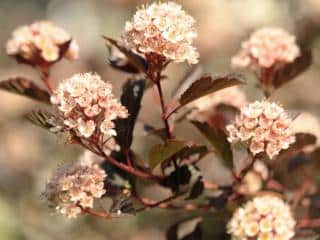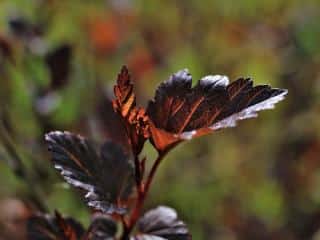

Physocarpus adds many benefits to your garden thanks to its low-maintenance nature and striking visual appeal.
Physocarpus at a glance:
Common name: Physocarpus
Family: Rosaceae
Type: shrub
Height: 5 feet
Exposure: full sun to partial shade
Soil: light, well-drained, non-limestone
Hardiness: hardy – Foliage: deciduous – Flowering: spring, summer.
Let yourself be taken away by this multi-faceted shrub!
This round-shaped shrub brings a wealth of interest to your garden:

While it loves some sunlight, certain varieties like P. opulifolius ‘Dart’s Gold’ are not fans of excessive sun exposure.
Optimally, you’d get your shrub in the ground at the beginning of fall. That’s when plants typically rebound best. But a spring planting could work too, as long as you keep a close eye on watering in the following months. Due to its proportions, Physocarpus can be planted in-ground or in pots.
The process is similar to in-ground planting. But you need to select a fairly large pot with a drainage system (and add a layer of clay balls at the bottom). The substrate should be a third peat soil and two-thirds potting soil. You can add vermiculite (perlite) to improve moisture retention.
Regardless of the growing method, don’t hesitate to apply mulch at the base of your shrub. It’ll limit water evaporation and keep soil moisture levels high.
→ Pine bark mulch is ideal because it’s slightly acidic
Trimming isn’t required for this plant. But if you’re feeling a bit adventurous, consider it after a few years to freshen things up. Just cut back older stems at their base, near the trunk. Do this after flowering, though.
Lack of water makes Physocarpus quite unhappy, so keep an eye on watering during extended dry spells, especially during those critical first few years of growth.
If you’re dealing with potted plants, here are a few extra steps:
 ing to give the roots a bit more room and fresh substrate.
ing to give the roots a bit more room and fresh substrate.Want more Physocarpus? Try cutting semi-woody pieces in late summer or taking and replanting suckers in fall.
Resilient and vigorous, Physocarpus doesn’t have to worry about diseases or seem to attract pests.
Plant this shrub in a flowerbed’s backdrop, a rustic hedge together with other striking species, or even standalone for smaller gardens and terraces.